Abstract
The role of tumour necrosis factor-alpha (TNF-alpha) in tuberculosis is paradoxical because although there is much evidence for a protective role, there is also evidence that it plays a part in the tissue damage that characterizes human disease. We have shown previously that TNF-alpha frequently induces necrosis when injected into sites undergoing delayed-type hypersensitivity (DTH) responses to mycobacterial antigen. This is dependent on CD4+ T cells. However the presence of this sensitivity to TNF-alpha-induced necrosis depended on the immunization protocol. We have tested the hypothesis that sensitivity to TNF-alpha depends on the cytokine profile of the induced T-cell response. All subcutaneous doses of mycobacterial immunogen used (10(7) to 10(9) organisms) primed spleen cells so that they secreted interferon-gamma (IFN-gamma) and interleukin-2 (IL-2) when cultured in vitro with soluble antigen. However priming for production of IL-4 was dose dependent as in other systems, and was produced at all times from 7 to 30 days after immunization with 10(9) organisms. Time-course studies over 30 days showed that sensitivity to TNF-alpha was found in DTH sites of animals primed for IL-4 and IFN-gamma production, but not in animals primed only for the Th1 cytokines. We suggest therefore that the paradoxical role of TNF-alpha can be resolved. In 'pure' Th1 responses it may act as an additional macrophage-activating factor. In mixed Th1 + Th2 or Th0 responses it may cause tissue damage. This mixed pattern is characteristic of tuberculosis, and of the late stage of many chronic infections where elimination of the infecting organism is failing, and chronic tissue damage is seen.
Full text
PDF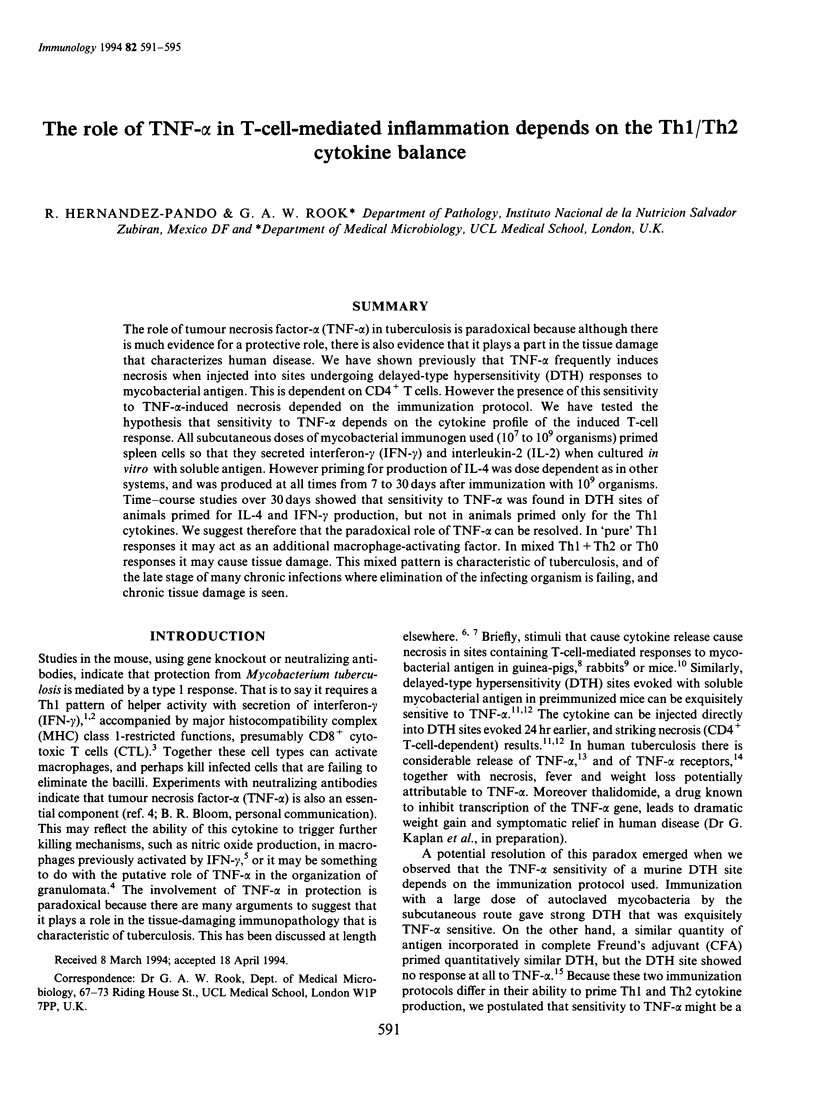
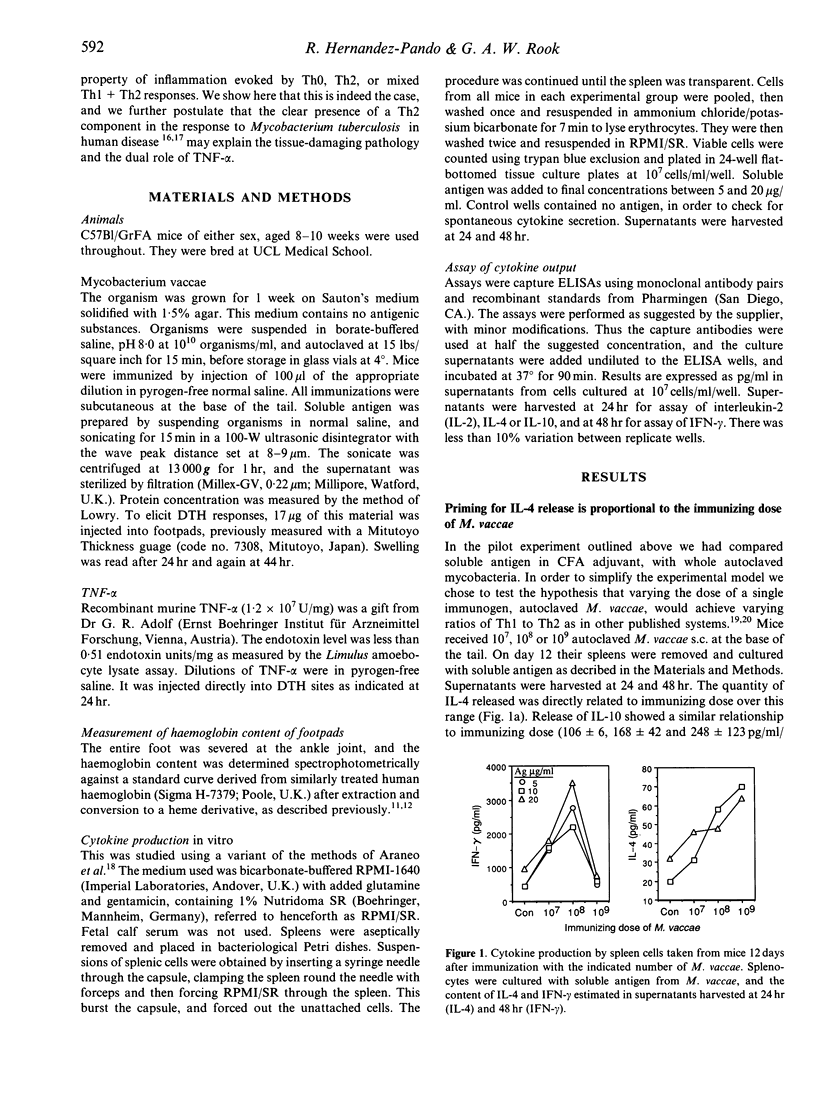
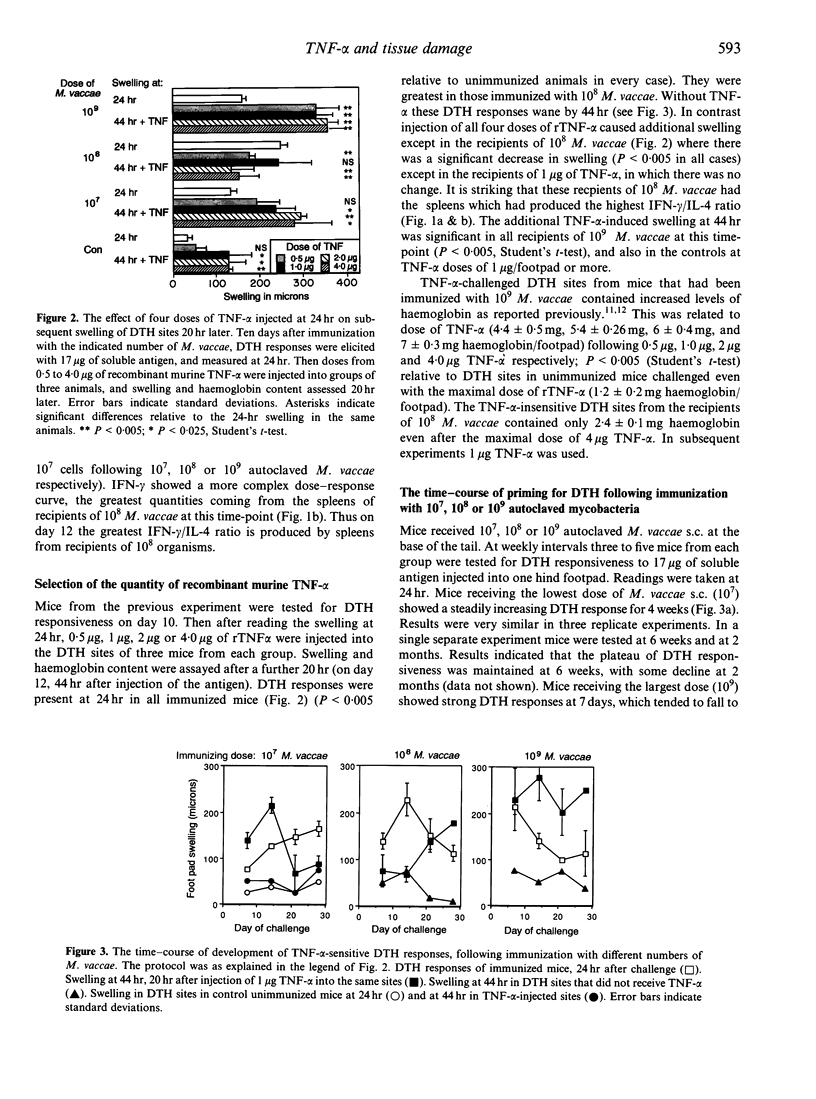
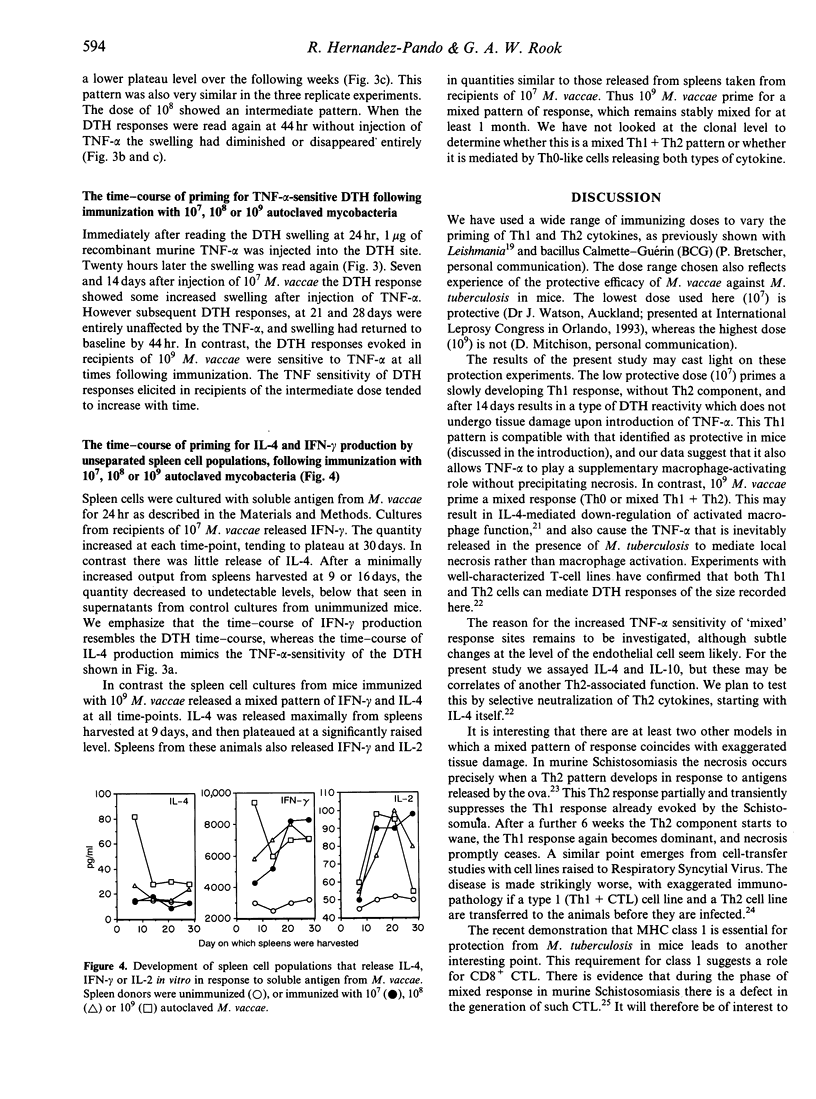
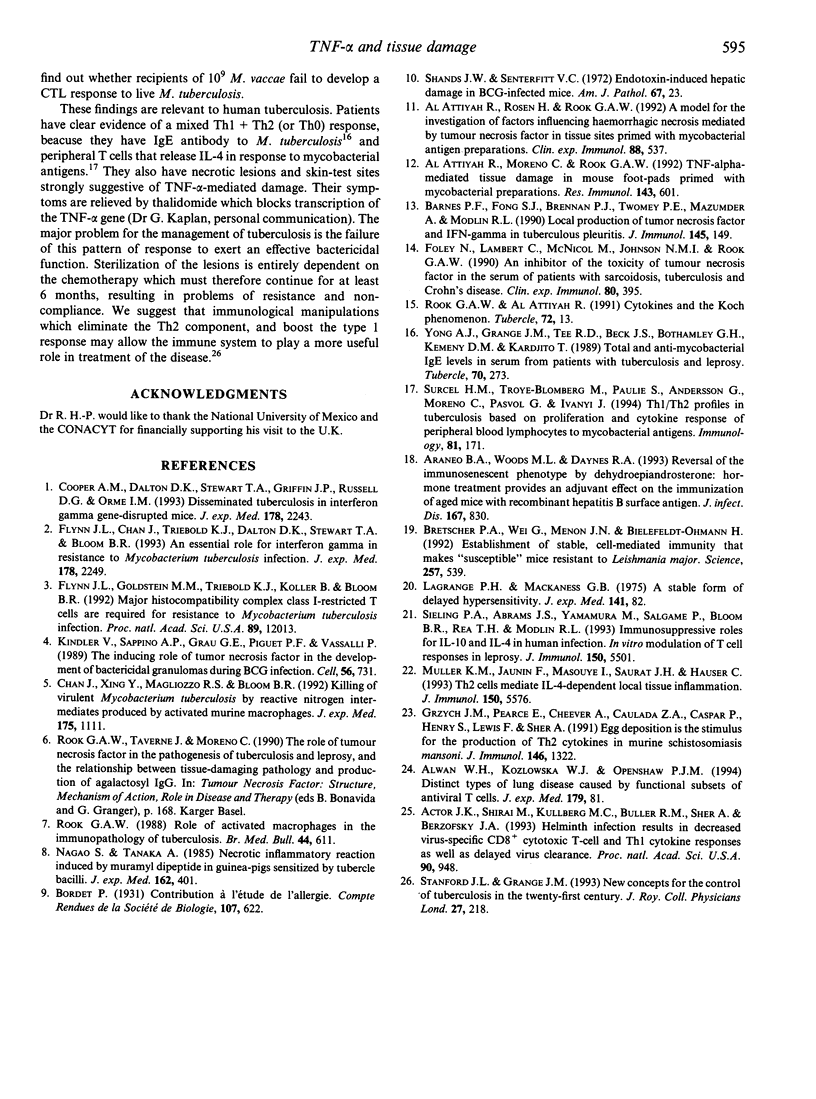
Selected References
These references are in PubMed. This may not be the complete list of references from this article.
- Actor J. K., Shirai M., Kullberg M. C., Buller R. M., Sher A., Berzofsky J. A. Helminth infection results in decreased virus-specific CD8+ cytotoxic T-cell and Th1 cytokine responses as well as delayed virus clearance. Proc Natl Acad Sci U S A. 1993 Feb 1;90(3):948–952. doi: 10.1073/pnas.90.3.948. [DOI] [PMC free article] [PubMed] [Google Scholar]
- Alwan W. H., Kozlowska W. J., Openshaw P. J. Distinct types of lung disease caused by functional subsets of antiviral T cells. J Exp Med. 1994 Jan 1;179(1):81–89. doi: 10.1084/jem.179.1.81. [DOI] [PMC free article] [PubMed] [Google Scholar]
- Araneo B. A., Woods M. L., 2nd, Daynes R. A. Reversal of the immunosenescent phenotype by dehydroepiandrosterone: hormone treatment provides an adjuvant effect on the immunization of aged mice with recombinant hepatitis B surface antigen. J Infect Dis. 1993 Apr;167(4):830–840. doi: 10.1093/infdis/167.4.830. [DOI] [PubMed] [Google Scholar]
- Barnes P. F., Fong S. J., Brennan P. J., Twomey P. E., Mazumder A., Modlin R. L. Local production of tumor necrosis factor and IFN-gamma in tuberculous pleuritis. J Immunol. 1990 Jul 1;145(1):149–154. [PubMed] [Google Scholar]
- Bretscher P. A., Wei G., Menon J. N., Bielefeldt-Ohmann H. Establishment of stable, cell-mediated immunity that makes "susceptible" mice resistant to Leishmania major. Science. 1992 Jul 24;257(5069):539–542. doi: 10.1126/science.1636090. [DOI] [PubMed] [Google Scholar]
- Chan J., Xing Y., Magliozzo R. S., Bloom B. R. Killing of virulent Mycobacterium tuberculosis by reactive nitrogen intermediates produced by activated murine macrophages. J Exp Med. 1992 Apr 1;175(4):1111–1122. doi: 10.1084/jem.175.4.1111. [DOI] [PMC free article] [PubMed] [Google Scholar]
- Cooper A. M., Dalton D. K., Stewart T. A., Griffin J. P., Russell D. G., Orme I. M. Disseminated tuberculosis in interferon gamma gene-disrupted mice. J Exp Med. 1993 Dec 1;178(6):2243–2247. doi: 10.1084/jem.178.6.2243. [DOI] [PMC free article] [PubMed] [Google Scholar]
- Flynn J. L., Chan J., Triebold K. J., Dalton D. K., Stewart T. A., Bloom B. R. An essential role for interferon gamma in resistance to Mycobacterium tuberculosis infection. J Exp Med. 1993 Dec 1;178(6):2249–2254. doi: 10.1084/jem.178.6.2249. [DOI] [PMC free article] [PubMed] [Google Scholar]
- Flynn J. L., Goldstein M. M., Triebold K. J., Koller B., Bloom B. R. Major histocompatibility complex class I-restricted T cells are required for resistance to Mycobacterium tuberculosis infection. Proc Natl Acad Sci U S A. 1992 Dec 15;89(24):12013–12017. doi: 10.1073/pnas.89.24.12013. [DOI] [PMC free article] [PubMed] [Google Scholar]
- Foley N., Lambert C., McNicol M., Johnson N., Rook G. A. An inhibitor of the toxicity of tumour necrosis factor in the serum of patients with sarcoidosis, tuberculosis and Crohn's disease. Clin Exp Immunol. 1990 Jun;80(3):395–399. doi: 10.1111/j.1365-2249.1990.tb03299.x. [DOI] [PMC free article] [PubMed] [Google Scholar]
- Grzych J. M., Pearce E., Cheever A., Caulada Z. A., Caspar P., Heiny S., Lewis F., Sher A. Egg deposition is the major stimulus for the production of Th2 cytokines in murine schistosomiasis mansoni. J Immunol. 1991 Feb 15;146(4):1322–1327. [PubMed] [Google Scholar]
- Kindler V., Sappino A. P., Grau G. E., Piguet P. F., Vassalli P. The inducing role of tumor necrosis factor in the development of bactericidal granulomas during BCG infection. Cell. 1989 Mar 10;56(5):731–740. doi: 10.1016/0092-8674(89)90676-4. [DOI] [PubMed] [Google Scholar]
- Lagrange P. H., Mackaness G. B. A stable form of delayed-type hypersensitivity. J Exp Med. 1975 Jan 1;141(1):82–96. doi: 10.1084/jem.141.1.82. [DOI] [PMC free article] [PubMed] [Google Scholar]
- Müller K. M., Jaunin F., Masouyé I., Saurat J. H., Hauser C. Th2 cells mediate IL-4-dependent local tissue inflammation. J Immunol. 1993 Jun 15;150(12):5576–5584. [PubMed] [Google Scholar]
- Nagao S., Tanaka A. Necrotic inflammatory reaction induced by muramyl dipeptide in guinea pigs sensitized by tubercle bacilli. J Exp Med. 1985 Aug 1;162(2):401–412. doi: 10.1084/jem.162.2.401. [DOI] [PMC free article] [PubMed] [Google Scholar]
- Rook G. A. Role of activated macrophages in the immunopathology of tuberculosis. Br Med Bull. 1988 Jul;44(3):611–623. doi: 10.1093/oxfordjournals.bmb.a072271. [DOI] [PubMed] [Google Scholar]
- Shands J. W., Jr, Senterfitt V. C. Endotoxin-induced hepatic damage in BCG-infected mice. Am J Pathol. 1972 Apr;67(1):23–40. [PMC free article] [PubMed] [Google Scholar]
- Sieling P. A., Abrams J. S., Yamamura M., Salgame P., Bloom B. R., Rea T. H., Modlin R. L. Immunosuppressive roles for IL-10 and IL-4 in human infection. In vitro modulation of T cell responses in leprosy. J Immunol. 1993 Jun 15;150(12):5501–5510. [PubMed] [Google Scholar]
- Stanford J. L., Grange J. M. New concepts for the control of tuberculosis in the twenty first century. J R Coll Physicians Lond. 1993 Jul;27(3):218–223. [PMC free article] [PubMed] [Google Scholar]
- Surcel H. M., Troye-Blomberg M., Paulie S., Andersson G., Moreno C., Pasvol G., Ivanyi J. Th1/Th2 profiles in tuberculosis, based on the proliferation and cytokine response of blood lymphocytes to mycobacterial antigens. Immunology. 1994 Feb;81(2):171–176. [PMC free article] [PubMed] [Google Scholar]
- Yong A. J., Grange J. M., Tee R. D., Beck J. S., Bothamley G. H., Kemeny D. M., Kardjito T. Total and anti-mycobacterial IgE levels in serum from patients with tuberculosis and leprosy. Tubercle. 1989 Dec;70(4):273–279. doi: 10.1016/0041-3879(89)90021-4. [DOI] [PubMed] [Google Scholar]
- al Attiyah R., Moreno C., Rook G. A. TNF alpha-mediated tissue damage in mouse footpads primed with mycobacterial preparations. Res Immunol. 1992 Jul-Aug;143(6):601–610. doi: 10.1016/0923-2494(92)80041-i. [DOI] [PubMed] [Google Scholar]
- al Attiyah R., Rosen H., Rook G. A. A model for the investigation of factors influencing haemorrhagic necrosis mediated by tumour necrosis factor in tissue sites primed with mycobacterial antigen preparations. Clin Exp Immunol. 1992 Jun;88(3):537–542. doi: 10.1111/j.1365-2249.1992.tb06483.x. [DOI] [PMC free article] [PubMed] [Google Scholar]


